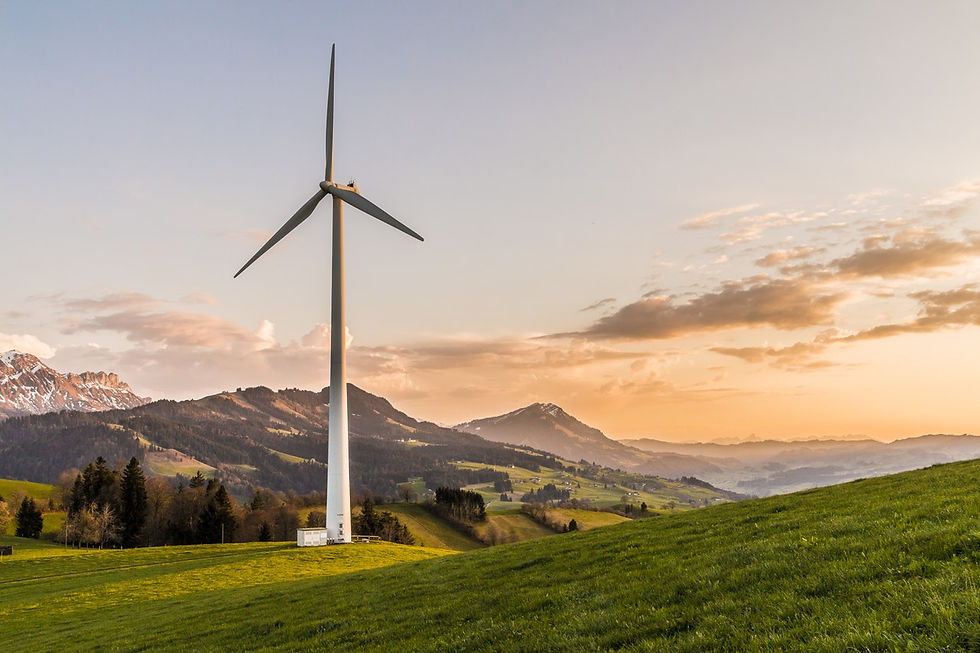Using AI, Blockchain and Drones in climate change
- Kartik Verma

- Jan 17, 2022
- 4 min read
Updated: May 26, 2022

Today we wanted to dedicate a whole edition to how emerging technologies (which may not fall under other themes like mining, aviation etc.) are helping in the fight against climate change.
What to expect today:
Artificial intelligence for optimizing wind power

Back in 2019 Google announced that it had made energy produced by wind farms more viable using the artificial intelligence software of its London-based subsidiary DeepMind. DeepMind and Google applied their machine learning algorithms to 700 megawatts of wind power capacity in the central United States.
How was Artificial Intelligence leveraged?
Using a neural network trained on widely available weather forecasts and historical turbine data, the team configured the DeepMind system to predict wind power output 36 hours ahead of actual generation.

Why do we need to predict output?
When it comes to wind power, making use of that energy can be difficult because knowing how much a given farm will generate and how best to store and then deliver that energy to the grid changes every day. This means we have to keep gas plants on standby and ready to fire them up anytime and because of the variability in power generation. If we can determine the output in advance, energy companies can rely on relatively cleaner sources (like coal or hydro) than gas and produce the deficit. Google claims that their machine learning algorithms have boosted the value of wind energy by roughly 20 percent, compared to the baseline scenario of no time-based commitments to the grid.
Source:Google Blog, Verge
Blockchain to track carbon credits

Cryptocurrency technology is making a splash in the carbon market. In recent months, millions of carbon credits for offsetting greenhouse-gas emissions have been virtually tied to newly created cryptocurrency tokens and removed from circulation.
What are carbon credits used for?
Many companies aiming to compensate for their emissions buy credits representing reductions in greenhouse gases. These credits, each standing for one metric ton of carbon dioxide, come from projects such as planting trees or setting up renewable energy farms that have third-party certification of the climate benefit. They are traded on informal markets, fetching different prices depending on the carbon-removal activity.
How can Blockchain help?
Carbon markets are highly unregulated and it’s difficult to determine which carbon credits are legitimate and the quality of the underlying carbon reduction projects tied to the carbon credits. In addition, it's difficult to track re-sale of carbon credits thus making the whole process a very risky affair for companies looking to buy carbon credits. Blockchain technology, with its ability to uniquely track-and-trace each underlying asset at the same time verifying the authenticity of the credits can help provide a solution.
Enter Toucan
Toucan, a nonprofit based in Switzerland, is one of several initiatives, aiming to overhaul the voluntary carbon market with clearer pricing and ownership data. Toucan lets users who own carbon credits link them to digital tokens. The tokens, called BCT—for Base Carbon Tonne—can then be traded on cryptocurrency exchanges. That wouldn’t change the nature of the underlying projects, but Toucan says it would create a forum for trading and improve transparency by providing real-time pricing data and a public record of trades to track who gets to take credit for funding climate-benefiting projects. The other popular platform is Klima which aims to do something similar.
Source: Wall Street Journal
Drones to plant trees

Deforestation is responsible for more than 15% of net global carbon emissions (comparable to the world’s entire transportation sector), making the protection of forests vital in the effort to reduce emissions. Dendra Systems‘ aerial seeding platform spread millions of seeds to create a koala corridor, in just a few hours. It’s one of the first times in Australia drone technology has been used to create koala habitat. The project is a collaboration between the World Wide Fund for Nature-Australia, the Australian Government, the Turner Family Foundation and Dendra Systems.
How does it work?
First, the replanting areas are identified using a combination of satellite images and drone-collected data. Specialized planting drones take to the skies loaded with seed pods containing a germinated seed and nutrients. Once in position, the drones use pressurized air to fire the seeds into the ground – at 120 pods per minute. The seedpods penetrate the earth and start to grow once activated by water. Dendra estimates its technology – combining speed and accuracy – would enable governments to restore forests 150 times faster than planting by hand, and up to 10 times cheaper. Check out the recommendation section to see it in action!
Drone can do more!
While this is a novel initiative of planting seeds through drones, drones with the right sensors can help conserve forests. For example, drones fitted with LIDAR sensors can help determine the forest cover and the health of the forest. Surveillance drones can be used for detecting illegal deforestation activities.
Source:WEF, Dendra Systems, Reuters
Recommendations from the team
YouTube - Watch a seed-planting drone in action (3 min video)
Ideas behind artificial intelligence without maths - Written by yours truly :D (10-min read)
YouTube - How a Blockchain works (6 min video)





Comments